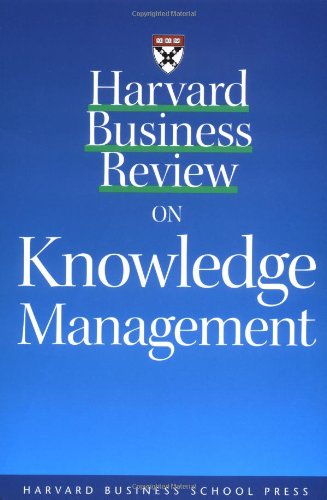
Why did I chose this resource?
I chose the chapter in this book to have a better understanding not only of our business, but also to gather analysis on predicted changes in modern business organizations worldwide.
What did you learn from it?
I learned that the generation of data, documented ideas, in modern society is accelerating. Not only is it accelerating, companies and non-profits are now realizing there is a wealth of relevant information when that data is converted into meaning within the context of running their day-to-day business. Thus data must be transformed in such a manner that is useful to the modern organization.
With respect to for-profit businesses, this gives them a competitive advantage and allows employees at varying levels to make better decisions.
This dissemination of meaning knowledge within an organization must be properly managed and structured. Due to this knowledge being disseminated organization-wide and made for use by employees among varying hierarchical levels it has also “flattened” traditional hierarchical management structures. Beforehand, mid-level managers and employees had to work on a spec (“painting the trees”) on the theory that focusing on such details would help fulfill upper-level management’s vision irrespective of whether or not employees understood the true supporting purpose of their required tasks / activities. Knowledge-creating companies now know their employees have a much more added awareness of the impact of their actions and are forced to keep the big picture in mind (“the forest”).
As a result this dissemination of data transformed into meaningful knowledge amongst a wide variety of employees with various roles, has simultaneously disseminated the potential for power among an organization’s workers to be a little less unequal amongst all areas of an organization.
As more and more organizations are providing their employees with useful knowledge to help them accomplish their goals and these employees may also be referred to as knowledge workers.
This chapter also reaffirmed something that I knew for a long time and wasn’t sure that everyone else understood and that is the concepts found in different areas of knowledge and their subsequent applications can be adopted into other areas of the principles behind those concepts can subsequently (but not always) be utilized for novel applications.
The Spiral of Knowledge: 4 basic patterns for creating knowledge in any organization.
-
Tacit to Tacit (Socialization)
-
Apprentice learning from Master)
-
-
Explicit to Explicit (Articulation)
-
Concrete information being used to create new knowledge
-
-
Tacit to Explicit (Combination)
-
Documentation / Production creation / Application of knowledge
-
-
Explicit to Tacit (Internalization)
-
Application of new knowledge and or underlying principles of concepts into other areas
-
Key Knowledge
- Acceleration in the accumulation of data is a business problem.
- Traditional managerial hierarchies are becoming flatter.
- Different styles of viewing the meaningfulness of business relevant information / knowledge: East (looks at ideals) and West (an emphasis on the quantification of knowledge for business purposes i.e. ROI).
- The best large organization will have no middle management at all. The knowledge is the manager: a combination of policy from the top and knowledge from every where.
- The Spiral of Knowledge: 4 basic patterns for creating knowledge in any organization
How are you using what you learned?
We are using this knowledge in such a manner that it helps us understand more and more the relevant in helping bring relevant business meaning to raw data that will empower our clients to make better, more well informed business decisions. It also forces us to realize the future may relay on search and subsequent reporting capabilities that can be implemented into a dashboard that employees may use to help them do their job better and help them keep an eye on making the sure that their activities help move their organization forward in accomplishing the “big picture.”
Key Changes
- Organize and structure knowledge in an easier to find and understand manner
- Learn what is important to our clients in terms of knowledge search and what metrics are important to their organization as we begin to develop a suite of reporting tools into Appleseed Search
How can we as a company or individuals in the company use this?
We can use this when we think about the needs of our clients, and anticipating their needs in the future that they are not aware that they will need yet in order to remain competitive. This can be used as part of the upsell process when we are in initial client meetings.
We can also use this to anticipate “sociological” or “operational” trends within organizations and adjust our own approach to business appropriately.
Key Actions
- Customer discovery as to current knowledge organization and search needs
- Customer discovery as to desired metrics reporting
- Implement Appleseed Search in our organization
Source
- Name : HBR on Knowledge Management
- Author : Compiled
- Physical Book: DC Office

